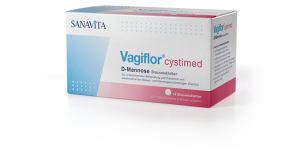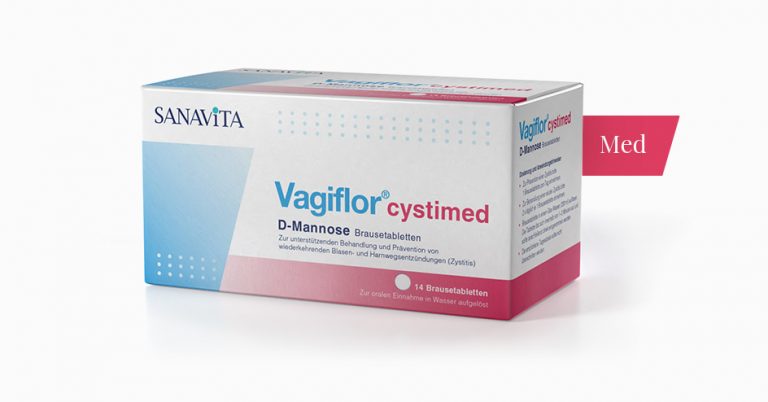Bladder infection – causes and symptoms – what helps?

Our hotline would be happy to help you with your concerns in a personal and confidential manner and is available to both pharmacies and patients.
06663-9604-16
info@vagiflor.de

Our hotline would be happy to help you with your concerns in a personal and confidential manner and is available to both pharmacies and patients.
06663-9604-16
info@vagiflor.de

The symptoms of a bladder infection, also known as cystitis, are very unpleasant. Any woman who has once suffered from it will recognise the typical symptoms of burning when passing urine, and a more frequent urge to do so, probably immediately. Lower urinary tract infections (UTIs) are amongst the most common bacterial infections and reasons for visiting a doctor.
Although a bladder infection is very unpleasant, it is mostly harmless and heals by itself. As a rule, there are no subsequent problems either.
The focus is therefore on quickly alleviating the unpleasant symptoms. In consultation with the doctor, a purely symptomatic treatment without antibiotics is the initial approach. In particular, women who suffer from recurrent bladder infections can benefit from natural but effective treatment possibilities.
Bladder infection – key facts at a glance
In this box, we have summarised all the relevant and useful information from this comprehensive article for you.
Symptoms: Burning and pain when passing urine, an increased urge to pass urine, difficulties in holding back the flow of urine, abdominal pains, cramps, cloudy urine, blood in urine.
Causes: The most common triggers are bacteria (in 80% of cases, Escherichia coli) that reach the urinary tract from the intestines via the urethra. Should these pathogens encounter an environment that allows colonisation, an infection may arise.
Diagnosis: Women who have already had cystitis will recognise the symptoms immediately. The doctor will make the diagnosis on the basis of symptoms and a urine culture.
Treatment: For an uncomplicated bladder infection, self-administered home remedies and painkillers, combined with cleansing and antibacterial substances such as D-Mannose, can suffice. During pregnancy, a doctor is likely to prescribe antibiotics if symptoms worsen, if the patient has fever, or if there is a pre-existing medical condition such as diabetes mellitus.
Risk factors: A weakened immune system, not drinking enough, cold and damp clothing, sexual intercourse, mode of wiping after using the toilet, genital hygiene, hormonal change, contraceptives such as spermicides and diaphragms, vaginal infections, pre-existing medical conditions.
Prevention: Drinking enough, regular use of toilet (including directly after sexual intercourse), strengthening the immune system; a study has shown that regularly taking D-Mannose is also effective.
Complications: A bladder infection can rise via the ureter to affect the kidneys. Without appropriate treatment, an infection of the renal pelvis and the kidneys (pyelonephritis) may occur. Untreated urinary tract infections can foster complications during pregnancy.
Note: Men suffer from bladder infections far less often, and if affected should immediately consult their doctor or urologist. Parents should also take their children to a doctor if they suspect a bladder infection. The symptoms tend to be unspecific until the child has reached a certain age.
How a urinary tract infection occurs
A urinary tract infection is the result of a germ, most commonly the intestinal bacteria E. coli. Other germs are much less common. In what doctors call an ascending infection, the bacteria reach the bladder and the characteristic symptoms are triggered (pain and burning when passing urine, more frequent urge to pass urine with small quantities). Medically speaking, there are two types of urinary tract infections, and the recommended treatment depends essentially on which of these types is present. A lower infection affects the urinary bladder and possibly the urethra, i.e. the lower reaches of the urinary tract. In an upper infection, the infection has spread from the bladder via the ureter to the renal pelvis and the kidneys. An infection that keeps coming back is known as a (chronic) recurrent urinary tract infection.
Factors encouraging development of a urinary tract infection
In general, women suffer from bladder infections much more frequently than men. The shorter urethra and the anatomical proximity mean that it is easy for intestinal bacteria to ascend to the bladder, become established and trigger the unpleasant symptoms.
Types of bladder infection
Physicians differentiate between different forms of cystitis. This is particularly important when it comes to selecting the right type of treatment. It also plays a role in deciding whether self-medication is appropriate or treatment should be supervised and prescribed by a doctor.

Complicated vs. uncomplicated cystitis: Uncomplicated cystitis occurs more frequently. We speak of uncomplicated cystitis when there are no functional or anatomical anomalies in the urinary tract and no other apparent circumstances which could favour other complications. Accompanying or pre-existing medical conditions such as diabetes mellitus, immune disorders and anatomical changes thus result in the diagnosis of complicated cystitis. When the affected patient is pregnant, a child or a man, the condition is also defined as complicated cystitis. For children, immediate medical advice is essential to avoid complications. A male bladder infection is comparatively rare and always requires further investigation in order to exclude conditions including prostatitis, prostate enlargement.
Differentiation between acute and chronic (recurrent) cystitis depends on the course the condition takes. With chronic cystitis, the symptoms of a bladder infection occur at least three times in one year or twice in six months.
A further distinction is made between bacterial cystitis (infection caused by bacteria) and abacterial cystitis (infection of the bladder without the involvement of bacteria).
An essentially unexplained bladder condition is medically termed interstitial cystitis. This is a chronic non-infectious inflammation of the bladder wall. The primary symptoms of interstitial cystitis are severe abdominal pain and the continual urge to urinate, combining to make everyday life impossible. Women are far more frequently affected by this condition than men. The causes are not yet known. Experts assume that inflammatory processes such as a prior bacterial bladder infection favour the development of this condition. As the illness is not yet well known, affected patients often have a long history of suffering behind them by the time the illness is diagnosed.
Asymptomatic bacteriuria during pregnancy is a special form of bladder infection. Bacteria can be found in the urine of a pregnant woman, but no typical symptoms are present. Antibiotics are prescribed in such cases to protect the health of mother and child and to avoid endangering the course of the pregnancy.
Are you familiar with the term “honeymoon cystitis”?
Many women report a bladder infection after sexual intercourse. Urinary tract infections are therefore more common on honeymoon. The increase in sexual activity results in physical demands and changes in the natural vaginal environment. This makes it easier for germs to build up and cause a bladder infection.
The typical symptoms of a urinary tract infection include burning and pain when passing urine and pain above the pubic bone. A bladder infection is also characterised by the continual urge to urinate with small quantities of at times cloudy, heavily concentrated urine. Blood is sometimes visible with the naked eye. It may be difficult to hold back the flow of urine.
If these symptoms are accompanied by fever, back pain and a strong feeling of being unwell, it can be assumed that the infection has spread from the bladder via the ureter to the renal pelvis. In such cases, physicians refer to this as pyelonephritis, a kidney infection.
How is an uncomplicated bladder infection diagnosed?
The doctor will ask about physical symptoms and test painfulness in the kidney area (renal percussive pain). It is normal to also ask if the patient suspects a bladder infection. This enables the doctor to assess with a high degree of accuracy if a urinary tract infection is present and to exclude other illnesses. A test strip indicating the presence of nitrite, leukocytes and/or blood in the urine will confirm the diagnosis. Midstream urine is used. The start and end of urine flow are flushed down the toilet, with the midstream flow captured in a small cup for testing purposes. This process eliminates sources of error in the evaluation of the urine. Should the patient also suffer from vaginal symptoms such as itching or discharge, a consultation with a gynaecologist is advisable.
Bladder infection urine test
Using a test strip, the midstream urine can now be examined for signs of bacterial growth. Amongst the most important parameters here are nitrite, leukocytes, blood and protein. Nitrite is product of the breakdown of bacteria. White blood cells, or leukocytes, indicate an infection in the body. These indicators, in combination with the characteristic symptoms, make a urinary tract infection highly likely. Where there is uncertainty, further laboratory tests are possible. These can identify the precise type of bacteria or other less common germs, such as fungus (Candida albicans), viruses and parasites.
In the case of recurrent bladder infections and additional complaints such as pain and fever, an ultrasound examination can provide clarity. This allows bladder stones and urinary retention to be identified and treated appropriately.
Why do women suffer from urinary tract infections more frequently after menopause?
A woman’s hormonal changes after menopause is responsible for a change in the vaginal mucosa, urethra and bladder. After menopause, not only do women suffer from such symptoms as vaginal dryness and pain during sexual intercourse; it is also easier for urinary tract infections to develop. In addition, there are changes to the pH level, resulting in a reduced presence of protective lactobacilli, also making it easier for infections.
Uncomplicated bladder infections often heal without any after-effects, meaning that the focus is on rapid alleviation of the unpleasant symptoms. Depending on the duration and intensity of symptoms, and in consultation with your doctor, treatment may proceed without antibiotics. This way, unnecessary antibiotic therapy can be avoided, along with the possible side-effect and increased resistance. In many cases, purely symptomatic treatment is enough.

One study has also shown that the unpleasant symptoms of a bladder infection – burning when passing urine, the increased urge to do so, and pain above the pubic bone – are eased by taking D-Mannose. This natural sugar attaches itself to E. coli, the main cause of bladder infections, preventing the bacteria from attaching itself to the bladder mucosa. The germ is then just passed out with the urine.
If symptoms get worse or persist for a few days, if you see blood in your urine, or if you experience fever, nausea or diarrhoea, it is essential that you see a doctor. Should antibiotics be necessary, a one-off or short-term treatment (normally 3 days) with fosfomycin-trometamol, nitrofurantoin, nitroxoline or pivmecillinam is recommended. In such cases, D-Mannose can provide natural support to the therapy and to alleviating the unpleasant symptoms.
A chronic recurrent bladder infection means that the symptoms occur at least three times per year or twice in six months. Initially, after thorough tests, avoiding risk factors and where appropriate strengthening the immune system, non-antibiotic treatment is used.
The natural D-Mannose sugar is recommended for preventing recurrent bladder infections. A clinical study has confirmed that taking D-Mannose can significantly reduce the occurrence of recurrent urinary tract infections.
A long-term antibiotic treatment is only used when preventive treatment options are not enough. Even then, a relapse can occur once the patient stops taking the antibiotic.
It’s not only physicians who are increasingly preferring rapid self-administered treatment of an uncomplicated bladder infection; women who know their bodies well are also adopting the approach. Antibiotics often have significant side-effects. There is growing public awareness of the issue of antibiotic resistance as a consequence of excessive and unjustified use of antibiotics. This, in turn, is raising the openness to alternative treatment approaches, thereby avoiding resistance.
With Vagiflor® cystimed, you can start independent treatment at home at the first sign of a bladder infection without losing any time. This gentle, targeted therapy rapidly alleviates the symptoms. It does not attack the natural vaginal environment, which is often disrupted as a result of antibiotic treatment. There is no need to fear side-effects such as the fungal infections that often follow antibiotic treatment.
Vagiflor® cystimed prevents the bacteria from attaching themselves to the mucosa of the bladder, thus supporting the body’s natural defence mechanisms. With enough to drink, the germs are then simply flushed out with urine. Vagiflor® cystimed can also be used preventively or, if necessary, parallel with antibiotics.
Frequently recurring urinary tract infections in particular need to be investigated properly so that a decision can be made about long-term medication. The preventive effectiveness of D-Mannose has been proven in a clinical study. The effect of the therapy is comparable to that of an antibiotic. This approach also avoids damaging the mucosa and the body’s natural defences.
Why do pregnant women more frequently suffer from bladder infections?
 Urinary tract infections are very common during pregnancy. The reason is the changed hormonal environment and the dilation of the urinary tract. This makes it easier for bacteria to develop. There is also a dilution of the urine, which therefore does not contain so many substances that can protect against an infection. An intact vaginal environment also protects against urinary tract infections. If the vaginal protection system is disturbed, the pH level can rise, which also promotes the growth of bacteria.
Urinary tract infections are very common during pregnancy. The reason is the changed hormonal environment and the dilation of the urinary tract. This makes it easier for bacteria to develop. There is also a dilution of the urine, which therefore does not contain so many substances that can protect against an infection. An intact vaginal environment also protects against urinary tract infections. If the vaginal protection system is disturbed, the pH level can rise, which also promotes the growth of bacteria.
Why is it important to consult a doctor if you have a bladder infection during pregnancy?
A doctor should be consulted immediately when symptoms of a bladder infection arise during pregnancy to protect the fetus itself.
Thorough questioning of the pregnant patient is accompanied by a physical examination, testing of a midstream urine sample, and the creation of a urine culture. The latter makes it possible to precisely identify the pathogen involved. Should the pregnant woman also has fever or pain in the side, a kidney infection (pyelonephritis) is possible and an ultrasound examination of the kidneys and urinary tract will be conducted.
A urine sample is checked at every check-up of the pregnant patient, so as to identify changes promptly and treat any infection as quickly as possible. In the event of a positive urine culture, antibiotics are prescribed to avoid a kidney infection and the danger of subsequent premature delivery or miscarriage.
Treatment of bladder infections during pregnancy
During pregnancy, experts recommend antibiotic treatment with β-lactam antibiotics. Penicillins and cephalosporins are the most well-tested of these. Fosfomycin- trometamol may also be administered. The antibiotics are aimed at preventing the bacteria from ascending and at protecting mother and child from harm.
If there is no therapy, this may endanger not only the health of the expectant mother but also and in particular, the course of the pregnancy. Consequences can include direct harm to the newborn and premature delivery. Medication is often refused or associated with real fear of harm to the child, which makes a thorough consultation with the doctor extremely important.
What you can do to protect yourself from a bladder infection
We have compiled the most important recommendations to ensure you are most effectively armed against an unpleasant bladder infection:
Sources
Stand: 11/2020

The natural D-Mannose sugar provides effective and lasting relief from acute symptoms such as a burning sensation when passing urine and the more frequent urge to urinate.
Read onStrengthened vaginal flora with a low pH value is a good defence against infection.
Read onLactic acid bacteria (lactobacilli) are essential for the health of the female genital area, as they determine the acidity of vaginal flora. The acidic environment of the vagina prevents germs from becoming established there.
Read onA child is growing and mum’s immune system now has to work for two. A healthy and balanced vaginal flora reduces the risk of infection for you and your child.
Read onThe healthy vagina is certainly not germ-free, but it has a natural protective function. A healthy balance depends on an acidic environment in which harmful yeasts and bacteria cannot survive.
Read on